| |
FRONT ORGANIZATION
|
|
| |
I. General
|
|
| |
The basic organization for Soviet Fronts varies in number of
subordinate units, strength, and type of equipment. The organization of a
particular Front depends on the following:
|
|
| |
- The area of operation - for example, Fronts facing NATO
forces are larger than Fronts inside the USSR;
- Assigned mission, defensive or offensive;
- The strength and quality of the enemy force.
|
|
| |
This chapter addresses a Front facing NATO.
|
|
| |
II. Organization of the Front:
A Front is composed of the following subordinate units:
Two or three Combined Arms Armies
One Tank Army (TA)
Tank Armies vary in the number of subordinate combat and support elements, but
their basic organization is standard (see Figure 2). The following units are
subordinate to a Tank Army:
- Three or four tank divisions;
- One motorized rifle division (MRD). The assignment of a MRD to a Tank Army is
not mandatory and depends on specific unidentified conditions;
- One brigade each of SCUD, air defense, artillery, reconnaissance, electronic
warfare, chemical, engineer and signal elements;
- These are similar to, but smaller than, the corresponding units in the
combined arms army;
- Rear Services: Tank Army rear services are similar but smaller than those of
the combined arms army;
- A four-division Tank Army consists of the following:
Strength - about 40,000 men;
Tanks - 1251;
Artillery and mortars - 400;
SCUD launchers - 9;
FROG launchers - 12-16;
Anti-tank weapons - 108.
One or two Combined Arms Corps
The organization and strength of the combined arms corps varies, but does not
exceed three divisions; two MRDs and one TD. No additional information on
organization, composition and equipment of a corps is available. While the
combined arms corps was mentioned at the Voroshilov General Staff Academy, a
corps organization was never utilized during various staff exercises or war
games at the academy. Seemingly corps were assigned to Fronts, such as those
with contingencies against Turkey or Iran, where the sectors are narrow and a
corps was deployed instead of a combined arms army.
From three to five Independent Motorized Divisions
One Air Army
The composition of organic Front air armies varies, depending on the
mission, airfields available, and capability of the enemy force (see Figure 3).
The following units are subordinate to the air army:
- Two or three fighter divisions which consists of three fighter regiments,
each with three squadrons. Each squadron has three four-aircraft flights;
- One or two fighter-bomber divisions with the same organization as a fighter
division;
- One bomber division with an organization similar to the fighter division,
except that a bomber flight has only three aircraft;
- Two air reconnaissance regiments which include a tactical reconnaissance
regiment, equipped with 40 MIG aircraft which conduct reconnaissance to a depth
of 500 km, the other regiment conducts operational reconnaissance to a depth of
1,000 km and is equipped with 33 bomber aircraft;
- One radio intercept and jamming regiment, equipment and strength unknown;
- Two or three air transport regiments equipped with about 32 transport
aircraft or helicopters each;
- Two or three reconnaissance drone squadrons, number unknown;
- Radio electronic warfare units consist of the follwing: One special purpose
aviation radio regiment; one special purpose radio technical battalion with
four SPB-7 and four SPB-8 radio electronic bombsight interference stations;
nine SPO-10 radio transmission interference stations; 24 R-834P radio jamming
stations; and four or five aviation radio jamming squadrons with one squadron
for each bomber and air reconnaissance regiment. Each jamming squadron has nine
aircraft equipped with unidentified radio jamming stations;
- Air army rear services are composed of the following elements:
one or two air army rear service bases;
one aviation technical regiment, consisting of three or four independent
aviation technical battalions (one battalion for each air division); two or
three independent aviation technical battalions (one battalion for each
non-divisional regiment of the air army); and several independent airfield
technical support companies (one company for each airfield used by subordinate
units of the air army).
One or two missile (SCUD) brigades ) see Figure 10)
The brigade have the following subordinate units:
- Three missile battalions, each with four SCUD missile TELs.
The SCUD missile can deliver nuclear warheads with a yield of 20, 40, or 100
KT;
- One fire direction battery;
- One missile transporter company;
- One meteorological battery;
- One engineer company;
- Various unidentified support and service platoons;
|
|
| |
Figure 10 missile (SCUD) brigade
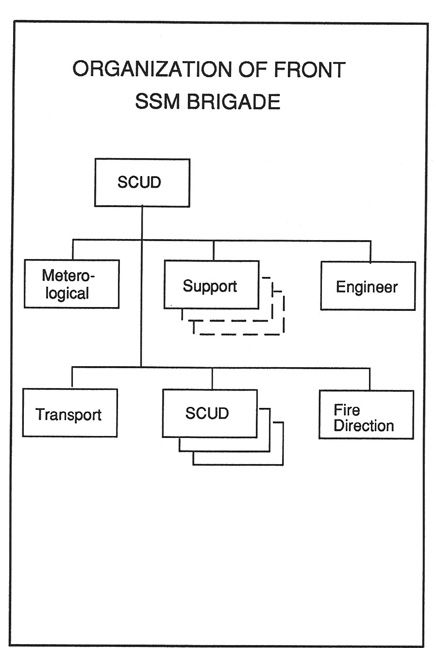
|
|
| |
Front Artillery
Soviet Fronts have no organic artillery units in peacetime. In wartime,
the Soviet Supreme High Command can assign the following artillery elements to
a Front (see Figure 11).
- From one to three artillery divisions: The organization of the artillery
divisions is unknown, but a division has 246 guns, mortars, and BM-21 multiple
rocket launchers;
- Two or three antitank artillery brigades: Each brigade consists of four
battalions of three batteries each, with 18 x 100mm antitank guns and one
battery with nine ATGM launchers;
- Recapitulation: A Front with 3-4 CAAs, 1-2 TAs, 5 Independent MRDs, 3 ADs and
3 AT brigades would have approximately 5,000 artillery pieces, mortars, and
BM-21s, 700 antitank guns, and 2,000 ATGMs.
|
|
| |
Figure 11 Supreme High Command artillery
units
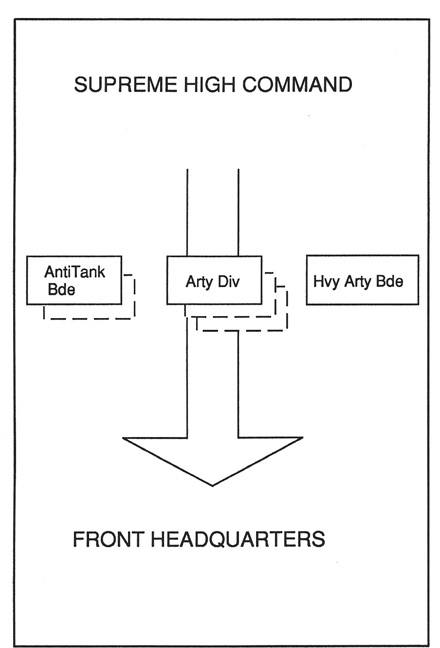
|
|
| |
Front Air Defense (see Figure 12).
Air defense support consists of the following units:
- Two or three SAM regiments equipped with SA-2 (S-75) missiles. Each regiment
has three launch battalions with 18 SA-2 launchers.
- One or two SAM regiments equipped with SA-3 (S-125) missiles. Each regiment
has three launch battalions with 12 SA-3 twin launchers.
- One antiaircraft artillery division consisting of three regiments, with six
firing batteries of 48 x 57 mm S-60 AAA guns.
- One air defense radio technical (radar) regiment with unknown organization
and equipment which supports all air defense elements.
|
|
| |
Front Air Defense Figure 12.
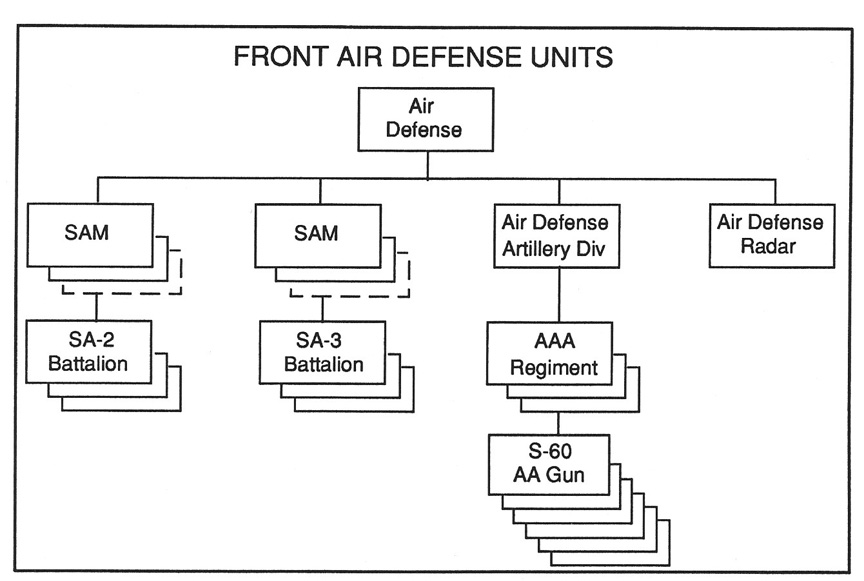
|
|
| |
Front Signal Units (see Figure 5):
- One command post (CP) signal regiment, with two battalions which operate from
two locations and provide communications to the Front CP.
- One rear services command post (RSCP) signal regiment consisting of two
battalions which operate from two locations and provide communications to the
Front RSCP.
- One forward command post (FCP) signal battalion operating from one location,
providing communications to the Front FCP. - One auxiliary control post
(ACP) signal battalion operating six auxiliary communication centers.
- One cable line communications battalion providing internal communications to
the FCPs.
- One radio and radio-relay surveillance and control center, which monitors and
controls military radio traffic in the Front area of operations.
- Two radio-relay battalions which provide radio-relay communications up to 450
km.
- One rear services long-range radio-relay battalion providing long-range
radio-relay communications to the Front rear services. - Two long-range
radio-relay battalion providing radio-relay communications up to 1,000 km.
- Two cable line battalions which use existing above-ground communications line
nets for Front communications needs.
- Three or four (depending on the number of Armies in the Front)
cable-laying battalions which lay communications cables from the Front
CP to the subordinate Armies up to 400 km.
- One or two (depending on the number of SCUD brigades in the Front)
cable-laying battalions which lay cable from the Front CP to the SCUD
brigades) up to 120 km.
- One mixed aircraft courier regiment with one aircraft squadron consisting of
six AN-2 and six YAK-12 aircraft and one helicopter squadron with 10 Mi-4 and
six Mi-2 helicopers. The regiment provides transportation from and to field
post centers and stations (message centers).
- Four communications equipment and spare parts depots, subordinate ot
Front rear services.
- One mobile signal equipment repair base, subordinate to Front rear
services.
- One cable line company utilizing existing underground communications lines
for Front communications.
- Field post and message service consists of two post office centers and
several stations which serve as distribution points for mail, classified
documents,and messages.
|
|
| |
Figure 5 Front signal units
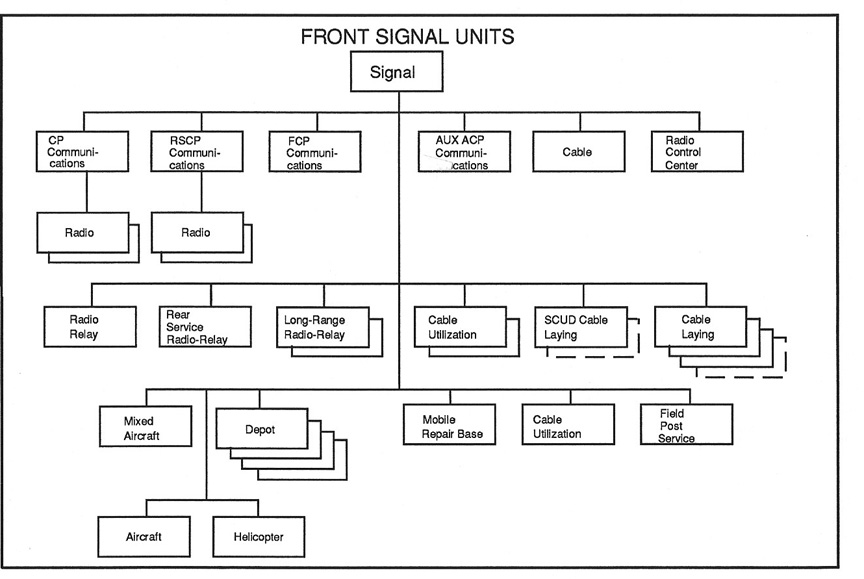
|
|
| |
Front Reconnaissance Operations (see Figure 13).
Clandestine reconnaissance (agenturnaya razvedka) methods are used in
operations in enemy territory in the Front's sector of operations. Some
of the agents (istochniki) operate in the target area in peacetime, while other
agents would be dispatached there immediately prior to the start of
hostilities. Special attention is paid to nuclear storage sites, headquarters,
and troop concentrations. The agents report back by radio.
- One independent special mission (OSNAZ) radio regiment composed of two radio
intercept battalions, five radio direction finding companies,one radio-relay
intercept company and one laboratory recon helicopter. The regiment can operate
97 radio intercept and 28 radio direction finding positions.
- One independent special mission radio technical regiment consisting of one
ground radar recon battalion, one radio intercept battalion, one recon aircraft
flight with two radar equipped aircraft and one laboratory. The regiment can
operate 46 radar and 50 radio inercept positions.
- One special purpose (SPETSNAZ) long-range reconnaissance battalion, capable
of deploying 35-40 airborne qualified long range recon teams.
- One airborne division.
|
|
| |
Figure 13 Front reconnaissance units
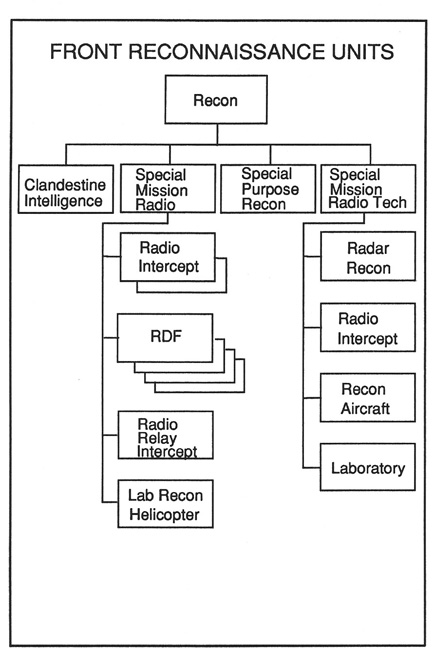
|
|
| |
Front Engineer Units (see Figure 14).
The engineer units in the Soviet Western Front are strong in bridge and
other river-crossing support because the north-south flow of European rivers
presents obstacles to Soviet advances to the west. Front engineer
support is composed of the following:
- One engineer road and bridge construction brigade consisting of three bridge
construction battalions, three road construction battalions, and one engineer
recon company.
- One engineer regiment consisting of three engineer battalions, one
fortification construction battalion, one camouflage company, and one engineer
recon company.
- One or two pontoon bridge regiments.
- One camouflage battalion consisting of two camouflage (makety) companies, one
technical company, and one radio deception platoon.
- One or two river assault crossing battalions.
- One or two mine recovery battalions which deactivated and collected mines
from minefields.
- One mine-laying battalion which laid mines and constructed obstacles.
- One control post (survey) engineer battalion supporting various Front
control posts.
- Two or three engineer equipment repair battalions.
- One or two engineer heavy equipment repair battalions.
- Two or three rear services engineer companies supporting Front rear
areas.
|
|
| |
Figure 14 Front Engineer Units .
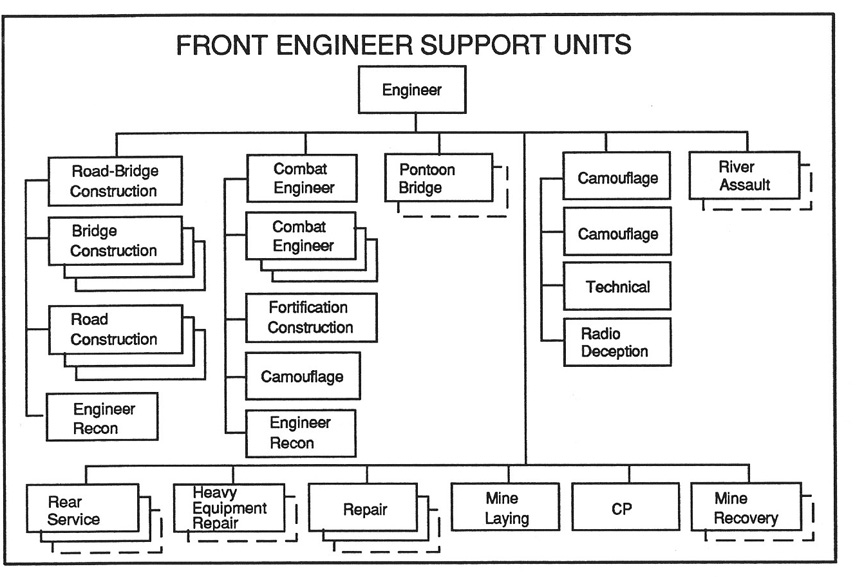
|
|
| |
Front Radio Electionic Warfare Units (see Figure 15).
- One special purpose radio technical battalion consisting of nine SPB-7 and
six SPB-8 radio electronic bombsight interference stations, 12 SPO-10 radio
transmission interference stations, six R-834P and two R-388 radio stations.
- One or two special purpose radio battalions with two radio jamming companies,
one direction finding company, one detection and targeting company, and one
signal company. A battalion has 18 R-325M radio stations.
- One special purpose aircraft squadron with nine aircraft equipped with R-949
radio stations.
|
|
| |
Figure 15Front Radio Electronic
Warfare Units
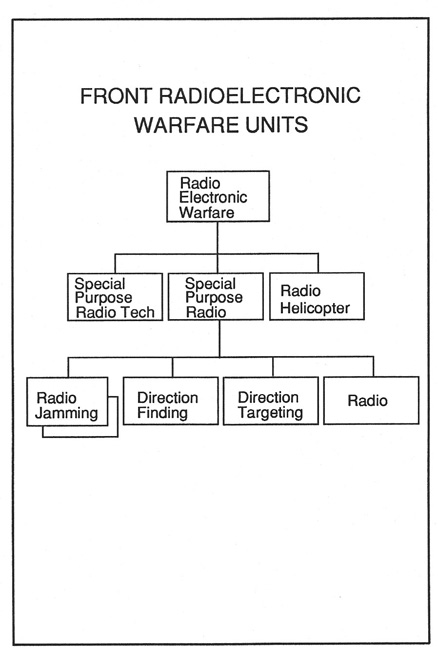
|
|
| |
Front Chemical Troops.
|
|
| |
Front Rear Services.
See the chapter on rear services of the Soviet Front.
|
|




